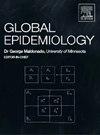Time-varying confounders in association between general and central obesity and coronary heart disease: Longitudinal targeted maximum likelihood estimation on atherosclerosis risk in communities study
引用次数: 0
Abstract
Aim
This study examines the association between general and central obesity and the risk of cardiovascular diseases, utilizing the Targeted Maximum Likelihood Estimator (TMLE) method to account for time-varying covariates and also we compares the findings with those derived from conventional regression methods in the Atherosclerosis Risk in Communities (ARIC) cohort study.
Methods
We considered 15,792 participants 45–75 years of age registered in the Atherosclerosis Risk in Communities study, visit 1 and followed to visit 4. General obesity defined as body mass index and central obesity defined as Waist Circumference (WC), Waist-Hip-Ratio (WHR), Waist-Height-Ratio (WHtR), Body Shape Index (BSI) and Body Roundness Index (BRI). The effect of obesity on Coronary Heart Disease (CHD) was estimated and compared by Longitudinal Targeted Maximum Likelihood Estimation (LTMLE) and generalized linear model.
Results
The effects of BMI, adjusted for baseline and time-varying confounders, was 1.15 (95 %CI =1.00, 1.34). About the gender groups, the effect of BMI for males and females was 1.17 (95 %CI =0.97,1.40) and 1.19 (95 %CI =0.94,1.52), respectively. Considering age groups, the effect of BMI was 1.21 (95 %CI =0.95, 1.53) and 1.13 (95 %CI = 0.93, 1.36) for age ≤ 54 years and age > 54 years, respectively. With regards to central obesity, the BSI and WC were shown the strongest effects, respectively. Among females and age group≤54 years, WHtR was associated with a higher incidence of CHD.
Conclusions
According to the results, the appropriate index for obesity varies based on gender and age. Knowledge about this difference will help to experts to implement appropriate interventions.
全身性和中枢性肥胖与冠心病之间的时变混杂因素:社区研究中动脉粥样硬化风险的纵向目标最大似然估计
目的:本研究利用目标最大似然估计(Targeted Maximum Likelihood Estimator, TMLE)方法来解释时变协变量,并将结果与社区动脉粥样硬化风险(ARIC)队列研究中传统回归方法得出的结果进行比较,探讨了一般肥胖和中心性肥胖与心血管疾病风险之间的关系。方法:我们纳入了15792名年龄在45-75岁之间的社区动脉粥样硬化风险研究的参与者,随访随访至随访4。一般肥胖定义为体重指数,中心性肥胖定义为腰围(WC)、腰臀比(WHR)、腰高比(WHtR)、体型指数(BSI)和身体圆度指数(BRI)。采用纵向目标最大似然估计(LTMLE)和广义线性模型估计和比较肥胖对冠心病(CHD)的影响。结果经基线和时变混杂因素调整后,BMI的影响为1.15 (95% CI =1.00, 1.34)。在性别分组中,BMI对男性和女性的影响分别为1.17 (95% CI =0.97,1.40)和1.19 (95% CI =0.94,1.52)。从年龄组来看,BMI对年龄≤54岁和年龄>的影响分别为1.21 (95% CI =0.95, 1.53)和1.13 (95% CI = 0.93, 1.36);分别是54年。对于中心性肥胖,体重指数和腰围分别表现出最强的影响。在女性和年龄≤54岁的人群中,WHtR与较高的冠心病发病率相关。结论根据研究结果,肥胖的适宜指标因性别和年龄而异。了解这种差异将有助于专家实施适当的干预措施。
本文章由计算机程序翻译,如有差异,请以英文原文为准。
求助全文
约1分钟内获得全文
求助全文

 求助内容:
求助内容: 应助结果提醒方式:
应助结果提醒方式:


